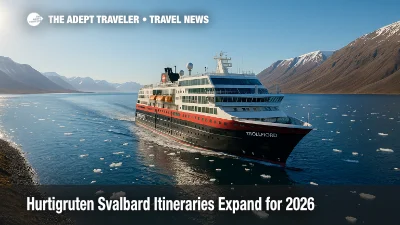Norway
Nestled in the embrace of the Scandinavian Peninsula, Norway beckons travelers with its dramatic landscapes and the whisper of ancient Norse legends carried on the wind. When you travel to Norway, a world of breathtaking vistas unfolds before you, where emerald fjords, like Geiranger and Nærøyfjord, carve their way through soaring cliffs crowned with snow, reflecting the shimmering northern lights in their pristine waters. The crisp, clean air carries the scent of pine forests and salt from the sea, while the melodic sound of cascading waterfalls in places like Vøringsfossen creates an orchestra composed by nature itself. As you wander through vibrant cities like Oslo and Bergen, the aroma of freshly baked lefse and the rich taste of brunost (brown cheese) invite you to indulge in Norway's culinary delights. Embark on this enchanting journey, where the horizon is painted with colors only found in the art of travel to Norway, and every experience promises to etch a lasting memory on the soul.
Norway Travel Season
The best time to travel to Norway largely depends on what visitors want to experience. While Norway offers magnificent sights throughout the year, the peak travel season is during the summer months from June to August. During this period, the weather is at its warmest, with long days and the famous phenomenon of the Midnight Sun in the northern regions. This is the height of tourist activity, where iconic fjords, hiking trails like the Pulpit Rock and Trolltunga, and vibrant cities like Oslo and Bergen are bustling. However, with comfort in weather comes larger crowds and higher prices on accommodations and tours.
For travelers who prefer fewer crowds and more moderate costs, the shoulder seasons of late spring, from May to early June, and early autumn, from September to early October, are ideal times to travel to Norway. During late spring, the snow is melting, giving way to lush landscapes and more accessible hiking paths. Autumn, on the other hand, is known for its dramatic foliage, creating stunning backdrops for photographs. Both seasons offer milder weather compared to the summer, making it perfect for outdoor activities without the rush of peak season tourism.
Other seasonal considerations offer unique experiences in Norway. Winter, from November to March, is captivating in its own right, particularly for those wanting to spot the ethereal Northern Lights or partake in winter sports like skiing or dog sledding. Destinations like Tromsø and the Lofoten Islands become major attractions during this time. Travel to Norway during winter might offer lower prices for flights and accommodations, but it requires preparation for colder conditions, especially in the country's northern reaches.
Local Events and Holidays
Travel to Norway also coincides with various local events and cultural festivities, adding enrichment to the journey. During the summer, numerous music festivals take place, such as the Bergen International Festival. In winter, Norway celebrates Christmas with traditional markets filled with local crafts and delicacies. Additionally, witnessing traditional celebrations like Norway's National Day on May 17th can provide deeper insight into the country's cultural heritage. Planning a travel itinerary around these events might also influence the timing and destination choices.
Off-Peak Perks
Traveling during the off-peak seasons not only provides a more secluded experience but also allows travelers to enjoy Norway's splendid offerings at a more relaxed pace. This period is well-suited for those who cherish solitude in natural settings or desire a tranquil holiday. By choosing to travel to Norway outside of the peak months, visitors might find themselves enjoying a more personalized interaction with nature and the country's hospitality.
Whether seeking adventure in the great outdoors or year-round cultural engagement, travel to Norway presents a palette of options that can cater to diverse interests. Different times of the year offer their unique allure, making any travel to Norway a rewarding experience suited to individual preferences and aspirations.
The Weather and Seasons in Norway
Travel to Norway promises an enchanting experience year-round, with a diverse climate that offers something unique in each season. As you plan your adventure, there are several climatic factors to consider to make the most of your trip. Norway is characterized by its three distinct climate zones: maritime, continental, and subarctic. This diversity creates a fascinating weather backdrop that varies dramatically depending on where and when you travel in the country.
Spring (March to May)
As winter recedes, travel to Norway in spring offers a glimpse of the country blossoming into life. During this season, temperatures gradually increase, with coastal areas experiencing milder conditions. In southern Norway, you can expect temperatures between 45°F (7°C) and 55°F (13°C), while inland and northern regions remain cooler. Rainfall becomes more frequent, particularly in Western Norway, contributing to lush, green landscapes. Spring is an excellent time to witness the thawing fjords and waterfalls come to life.
Summer (June to August)
Summer is a popular time to travel to Norway, thanks to its pleasantly mild weather and extended daylight hours. Coastal areas typically experience temperatures ranging from 60°F (16°C) to 70°F (21°C), while inland areas can reach up to 80°F (27°C). The "midnight sun" phenomenon is a hallmark of the Norwegian summer, particularly above the Arctic Circle, where the sun never fully sets. Rainfall is more frequent in the west, but overall, the summer offers great conditions for outdoor activities like hiking, biking, and exploring the fjords. Summertime in Norway is perfect for nature enthusiasts and adventurers alike.
Autumn (September to November)
As the vibrant landscapes of summer transition, travel to Norway in autumn offers a captivating palette of colors. Temperatures start to cool, with southern Norway experiencing highs around 55°F (13°C) to 65°F (18°C). In the north and mountainous regions, the air becomes crisper, and early snow can dust the landscape as early as late October. Rainfall remains a possibility, especially in the coastal areas. Despite unpredictable weather, autumn can be a magical time with fewer tourists, offering a more intimate experience of Norway's breathtaking vistas.
Winter (December to February)
Winter in Norway transforms the country into a snowy playground for both locals and travelers. Temperatures vary significantly from south to north; Oslo and other southern areas experience averages around 20°F (-6°C) to 30°F (-1°C), while northern regions can plummet to –13°F to 5°F (-25°C to -15°C). Snow is plentiful, particularly in the inland and northern parts, making it ideal for winter sports enthusiasts seeking skiing, snowboarding, and snowshoeing adventures. Aurora borealis, or the northern lights, can often be witnessed during winter, especially in areas located above the Arctic Circle.
Travel to Norway is particularly favorable in the summer due to its comfortable temperatures and countless daylight hours, allowing for maximum exploration time. However, each season holds its own charm and is tied to local events and festivals. For instance, in winter, the Sami people celebrate traditional reindeer races, providing a unique cultural experience for visitors.
Whether you're visiting the vibrant cities, exploring the expansive wilderness, or chasing the northern lights, travel to Norway offers a climate as diverse and awe-inspiring as its landscapes. Understanding what each season brings will help tailor your journey to ensure a memorable and enjoyable adventure in this Scandinavian gem.
Accepted Payment Methods and Other Payment Information in Norway
When planning a journey to Norway, understanding the payment landscape is crucial for seamless transactions. Norway's official currency is the Norwegian Krone (NOK), which is the standard for all monetary transactions throughout the country. It’s important to familiarize yourself with the exchange rate if you’re bringing foreign currency, although most travelers find it convenient to use credit cards or digital payment methods during their stay in Norway.
Credit card usage is widespread in Norway, making it easy for travelers to make purchases without needing to carry large amounts of cash. Visa and Mastercard are widely accepted across various establishments, including restaurants, hotels, and shops, making them reliable options when traveling to Norway. American Express is accepted in many places, although it’s not as universally recognized as Visa or Mastercard. Discover cardholders may find fewer locations that accept their card, so it's advisable to have a backup payment option, such as a Visa or Mastercard, when visiting Norway.
Despite the prevalence of card payments, having some cash on hand remains useful, especially for small transactions, markets, and rural areas where card readers might not be available. ATMs are widely available in towns and cities, offering a simple way to withdraw local currency using international cards. It’s also essential to note that Norway relies heavily on contactless payments and mobile payment apps, such as Vipps, for quick and efficient transactions.
Tipping Etiquette
Travelers to Norway are often curious about tipping etiquette. Generally, tipping is not a substantial part of the culture and is not obligatory. Norwegians receive fair salaries, and service charges are typically included in your bill. However, if you feel the service was exceptional, rounding up the bill or leaving a small tip is appreciated, but not expected. When paying by card, you may be given the option to add a gratuity to the total amount.
For those preparing to travel to Norway, it’s essential to understand these payment nuances to avoid any inconvenience. Ensure your credit card company is aware of your travel plans to prevent any transaction issues while abroad. By familiarizing yourself with Norway's payment methods and extremely efficient banking systems, you’ll be better prepared for a smooth travel experience in this stunning Scandinavian country.
Why You Should Travel to Norway
Travel to Norway promises an unforgettable experience, with its breathtaking natural landscapes, rich cultural history, and thrilling activities. One of the most compelling reasons to visit Norway is its stunning fjords. These deep, glacially carved valleys surrounded by towering cliffs offer some of the most awe-inspiring views on the planet. Travelers can embark on scenic cruises or hikes to experience the grandeur of these natural wonders up close. The Geirangerfjord and Nærøyfjord, both UNESCO World Heritage Sites, are particularly renowned for their beauty.
Aurora Borealis
Norway is one of the best places in the world to witness the Northern Lights, or Aurora Borealis. Travelers flock to the Arctic regions during the winter months for a chance to see these magical green and purple lights dancing across the sky. The city of Tromsø and the Lofoten Islands are popular spots for experiencing this natural phenomenon. Norway's high latitude and clear skies make it an ideal destination for Aurora chasers.
Viking Heritage
For those interested in history, Norway offers a rich tapestry of Viking heritage to explore. Visitors can delve into the past by visiting the Viking Ship Museum in Oslo, where they can view ancient Viking ships and artifacts. The country's numerous archaeological sites and reconstructed Viking villages, such as the one at Avaldsnes, allow travelers to step back in time and gain a deeper understanding of Norway's storied past.
Breathtaking Outdoor Adventures
From skiing in the winter wonderland of the Norwegian mountains to hiking along the rugged coastlines during the summer, outdoor enthusiasts will find plenty to excite them in Norway. The nation is a haven for adventure sports, with activities such as kayaking, rock climbing, and cycling available across its diverse terrain. The Jotunheimen National Park, known for its high peaks and scenic trails, is a favorite among hikers.
Vibrant Cities
Travel to Norway is not just about nature; its cities offer a vibrant cultural scene as well. Oslo, the capital city, is known for its modern architecture, art galleries, and lively waterfront. Bergen, with its colorful wooden houses and bustling fish market, provides a charming glimpse into traditional Norwegian life. These urban centers offer a blend of old-world charm and contemporary sophistication.
Cultural Festivals
Norway hosts a variety of festivals that celebrate its rich culture and traditions. The Bergen International Festival, Northern Europe's largest arts festival, attracts artists from around the world. Meanwhile, the Sami People’s Easter Festival in Kautokeino showcases the indigenous culture of Norway's Arctic region with music, reindeer racing, and joik singing. These events provide travelers with a unique opportunity to experience Norse culture firsthand.
Spectacular Wildlife
Norway is home to an array of wildlife, making it a prime destination for nature lovers. Visitors can embark on whale-watching expeditions to see majestic creatures like orcas and humpbacks, or explore the Svalbard archipelago, where polar bears roam the icy landscapes. Birdwatchers will appreciate the vast colonies of seabirds found along Norway's cliffs and islands.
Majestic Waterfalls
The travel experience in Norway is enhanced by its numerous magnificent waterfalls, each offering a breathtaking sight. Vøringsfossen in Hardanger is one of the most famous, with its dramatic drop into a deep canyon. The Land of Waterfalls also includes the impressive Langfoss and Kjosfossen, each contributing to Norway's reputation as a land of abundant natural beauty.
World-Class Cuisine
The culinary scene in Norway is blossoming, with a focus on fresh and local ingredients. Travelers can savor traditional dishes like rakfisk, cured fish, and lutefisk, dried fish treated with lye, along with newer gourmet offerings in Oslo's burgeoning restaurant scene. The country's seafood, straight from the icy waters, is especially renowned, offering a true taste of Norwegian heritage.
Innovative Architecture and Design
Norway's innovative architecture and design are evident in its urban landscapes and remote countryside. Structures like the Oslo Opera House, with its sloping, walkable roof, and the Arctic Henge in Rjukan highlight the nation's commitment to blending functionality with aesthetics. This fusion of tradition and modernity is a testament to Norway's forward-thinking design ethos, drawing architects and enthusiasts from around the world.
When you travel to Norway, you'll find a land of contrasts and unparalleled beauty. From the spectacular fjords to the cultural festivals, every aspect of Norway beckons you to explore and appreciate its wonders. Each visit promises a distinctive experience that leaves a lasting impression.
The History of Norway
Norway holds a fascinating place in world history, a land sculpted by glaciers and rich with sagas of the Vikings. For history lovers looking to travel, Norway offers a journey through time from ancient beginnings to its role as a modern, influential nation. The Viking Age, which lasted from approximately 793 to 1066, was a significant era in Norway's past when Norse explorers expanded their territories, leaving a legacy of shipbuilding, navigation, and trade. Places such as the Viking Ship Museum in Oslo house incredible artifacts from this time, giving visitors an immersive glimpse into Viking life and culture. Travel to Norway to witness these relics that recount tales of seafaring, conquest, and settlement.
Upon deciding to travel to Norway, visitors will find a rich tapestry of history interwoven with myth and reality across its varied landscapes. In the medieval period, Norway became part of a larger European story through the formation of strategic and royal alliances, including the Kalmar Union. The history that followed in the centuries to come was marked by a series of conquests and unions with Denmark and Sweden, deeply influencing its cultural and architectural heritage. Travelling through cities like Bergen, with its preserved wooden structures, and Trondheim, home of the Nidaros Cathedral, offers insight into the intertwined past of religion, power, and cultural development in Norway. These landmarks are not just tourist spots but living libraries of artistry and history that inspire all who visit.
As one travels to Norway, one discovers more than its medieval castles or Viking ships; the true beauty lies in its ability to blend the ancient with the new. The path to independence in 1905 allowed for the surge of national identity and cultural renaissance, positioning Norway uniquely on the world stage. This transformation is visible in the country’s modern architecture and cultural institutions. The striking design of the Oslo Opera House and the innovative exhibitions at the National Museum challenge visitors to appreciate both classical and contemporary Norwegian contributions to art and culture. For travelers interested in modern history shaped by robust social policies and economic growth driven by oil discoveries, Norway’s narrative is a compelling study of progress and foresight.
The reasons to travel to Norway extend beyond its pristine natural beauty or efficient modern cities; it's a country where history breathes through landscapes and landmarks. Experience the Sami culture, an indigenous history that stretches far before the first Viking set sail, across the Arctic Circle in the northern reaches. Festivals, traditional crafts, and storytelling are testament to a vibrant cultural heritage still alive today. Exploring this depth of history throughout Norway will enrich your understanding of a nation that respects its past and pioneers its future. Whether your interest lies in the epic saga of the Vikings or the dynamics of modern European development, history lovers will find Norway an enriching destination to discover time and again.
The Culture of Norway
For those planning to travel to Norway, the allure of its rich cultural heritage is undeniable. Norway boasts a vibrant tapestry of traditions and customs that have been woven together over centuries. One of the most enduring aspects of Norwegian culture is its connection to the natural landscape. This relationship is celebrated through traditions such as "friluftsliv," a commitment to spending time outdoors regardless of the season. Norwegians hold dear the practice of embracing nature, and whether it's hiking through breathtaking fjords or enjoying the northern lights, these activities are an integral part of daily life. Visiting during Christmas or Easter allows travelers a glimpse into Norway's festive side, which includes traditions like "lutefisk" meals and church services that reveal the country's deep-rooted Christian heritage.
Norway's calendar is peppered with vibrant festivals that highlight its cultural uniqueness. From the Sami people's "Jokkmokk Market" to the lively celebrations of Constitution Day on May 17th, there’s a festival for every interest. During these events, locals don traditional costumes, known as "bunad," and participate in parades filled with music, dance, and community spirit. The Sami, Norway's indigenous people, are particularly celebrated for their rich cultural contributions. Their traditional singing, known as "joik," is a distinctive form of music that speaks to the deep connection with their ancestral lands. These festivals offer a unique opportunity for visitors to travel to Norway and experience a myriad of cultures blending harmoniously.
As one ventures into the arts scene in Norway, the country's flair for artistic expression becomes undeniable. Norway has a rich history in visual arts, from the haunting landscapes of Edvard Munch to contemporary design found in Oslo's architecture. Travelers interested in the arts will find a myriad of galleries and museums, such as the Munch Museum and the National Gallery, which showcase both historical and modern Norwegian artistry. In addition to visual arts, music plays a pivotal role in culture, with genres ranging from traditional folk to black metal. Norway continues to nurture its artistic talents, as seen by its numerous music festivals and cultural events throughout the year. For those who travel to Norway, the country's art scene offers an enriching experience that is both historical and cutting-edge.
The cultural tapestry of Norway is further enriched by its commitment to preserving indigenous and historical traditions while embracing modern multicultural influences. Immigration has introduced diverse culinary tastes, languages, and customs, ensuring that Norway's cultural offerings are continuously evolving. This creates a dynamic society where traditional Norwegian values coexist with fresh, global influences, providing visitors with a unique cultural experience. Community efforts to preserve the Sami culture, support the performing arts, and protect natural heritage sites further showcase Norway's dedication to cultural preservation. When travelers visit Norway, they're not just visiting a country; they're stepping into a living, evolving mosaic of tradition and innovation. The experience of Norway's vibrant cultural landscape is a profound reminder of how history and modernity weave together to create a unique national identity.
The Culinary Experience of Norway
When you travel to Norway, prepare yourself for a rich and dynamic culinary journey that mirrors the country's majestic landscapes and deep-rooted traditions. The essence of Norwegian cuisine is deeply interwoven with the country's geography, with its extensive coastline providing an abundance of fresh seafood, and the fertile valleys offering a bounty of fruits and vegetables. You'll find that Norway celebrates its culinary heritage with simplicity and freshness, focusing on high-quality, seasonal ingredients. There's a tremendous sense of pride in local produce, sustainable farming, and culinary innovation, which are evident in every dish you try.
As you travel to Norway, some must-try dishes should be on every food lover's itinerary. Norwegian salmon, renowned for its quality and taste, is a staple that you’ll find prepared in various ways—grilled, cured as "gravlaks," or smoked. "Rakfisk," a traditional fermented fish, offers a unique taste experience for the adventurous palate. Meat lovers should indulge in "fårikål" (mutton stew with cabbage), a hearty dish that is a national favorite, particularly during colder months. Sweet treats are not forgotten; "krumkake," a delicate waffle-like cookie, is a perfect example of the country’s penchant for simple yet delightful desserts.
Beverages in Norway offer another layer to the culinary exploration. The country produces several craft beers, with microbreweries gaining popularity across the regions. Akvavit, a traditional spirit flavored with herbs such as dill or caraway, is often enjoyed during celebrations and festive meals. Although Norway’s climate isn’t ideal for viticulture, wine lovers will appreciate the local cider made in the fruit-growing region of Hardanger, which provides a refreshing option. Travelers should also take the opportunity to sample traditional Norwegian non-alcoholic drinks, like the creamy, caffeine-free malt beverage "maltøl."
Dining experiences in Norway offer something for everyone, from bustling food markets to high-end fine dining establishments. Traveling through cities like Oslo and Bergen, you'll encounter food markets that showcase the best of Norwegian produce, offering street food options like fresh "pølse" (Norwegian hot dogs) that are perfect for on-the-go enjoyment. Norway also respects diverse dietary needs, with restaurants increasingly providing vegetarian and vegan options, ensuring that every traveler can enjoy the rich tapestry of Norwegian cuisine. Seasonal dishes play a significant role, with celebrations of local food punctuated by several food festivals throughout the year, providing an immersive way to experience the country’s gastronomic culture.
What to See and Do in Norway
Exploring Norway is a traveler’s dream, with its breathtaking landscapes, rich history, and vibrant culture. Every journey to the Land of the Midnight Sun offers travelers unforgettable experiences. From the majestic fjords to the shimmering Northern Lights, travelers are sure to create lifelong memories.
Witness the Northern Lights in Tromsø
For those looking to travel to Norway in pursuit of nature's most mystical light display, Tromsø is the gateway to experiencing the Northern Lights. Known as the “Paris of the North,” Tromsø is set amid picturesque fjords and mountainous landscapes, offering travelers the best opportunity to witness the Aurora Borealis. Nightly tours, led by experienced guides, enhance the experience, providing travelers with the best vantage points while sharing tales of the phenomenon's cultural significance.
Embark on a Fjord Cruise
Travelers to Norway cannot miss a scenic fjord cruise, the epitome of Norway's natural beauty. Whether navigating the narrow, winding Geirangerfjord or the vast, serene waters of the Sognefjord, each cruise provides unique panoramas of towering cliffs and cascading waterfalls. Families and adventure seekers alike will find tranquility and awe in this quintessential Norwegian experience. The fjords are UNESCO World Heritage sites, and each bend of the seascape reveals nature’s masterpiece.
Explore the Lofoten Islands by Kayak
For adventure seekers traveling to Norway, kayaking through the stunning Lofoten Islands offers an unmatched experience. These islands boast dramatic peaks and charming fishing villages that can be explored up close from the water. With a kayak, travelers can glide past rocky coastlines and venture into secluded bays, offering a serene escape into the heart of the archipelago’s breathtaking landscapes. The colorful Rorbu cabins provide a taste of traditional Norwegian life and complete this unique journey.
Discover the Historic Bryggen Wharf in Bergen
Travelers interested in cultural history should visit Bryggen in Bergen, a UNESCO World Heritage site. The colorful wooden buildings along the wharf, once a thriving Hanseatic League trade center, offer incredible insights into Norway's medieval trade history. Strolling through the narrow alleyways of this historic district, visitors will find charming shops, cozy cafes, and museums that bring to life the bustling commerce of centuries past. It’s a perfect stop for solo travelers and history enthusiasts alike.
Ride the Flåm Railway
The Flåm Railway is a must-ride for train enthusiasts or those wanting to experience Norway's awe-inspiring scenery from a unique perspective. The journey, frequently touted as one of the most beautiful train rides in the world, starts in the high mountains of Myrdal and descends through lush valleys and beside flowing waterfalls to the village of Flåm. This adventure is perfect for families, offering an educational and exciting travel experience amidst Norway’s natural splendor.
Hike Preikestolen (Pulpit Rock)
Pulpit Rock is one of Norway's most iconic hikes, attracting travelers with its stunning views over the Lysefjord. This well-marked trail offers a moderate four-hour round trip, culminating at a flat-topped rock with a dizzying 604-meter drop. The experience is as rewarding as it is challenging and provides an adrenaline rush combined with panoramic views for thrill seekers who travel to Norway in search of outdoor adventures.
Delve into Viking History in Oslo
The Viking Ship Museum in Oslo offers travelers an exciting opportunity to delve into Norway's Viking past with its impressive collection of authentic Viking ships and artifacts. Perfect for families and history buffs, the museum showcases excellently preserved ships dating from the ninth century and provides interactive exhibits that engage visitors of all ages. Here, travelers can immerse themselves in the seafaring culture that once dominated the North Sea and understand the fearless spirit of the Vikings.
Sample Norwegian Cuisine in a Rorbuer
Norway offers a delightful culinary journey for travelers who appreciate good food. In the coastal Rorbuer, traditional Norwegian fishing cabins, travelers can indulge in fresh seafood, such as arctic cod and king crab, prepared in the local style. This authentic setting provides a deeper connection to Norwegian customs and is a perfect gastronomic experience after a day of exploring the rugged coastlines of Norway.
Visit the Arctic Cathedral in Tromsø
The Arctic Cathedral is a remarkable feat of modern Norwegian architecture and one of Tromsø's most recognizable landmarks. Inspired by the landscapes of the Arctic, the cathedral's design mimics the icebergs and snow-covered peaks that surround the city. Inside, travelers can enjoy a unique cultural experience, often with live concerts that blend Norwegian folk with contemporary music beneath the cathedral's notable stained-glass windows.
Journey to the North Cape
The North Cape is for travelers to Norway seeking the northernmost point in Europe for an unmatched view of the Arctic Ocean. Famous for its dramatic, sheer cliff standing 307 meters above sea level, it’s a serene and surreal place to experience the Midnight Sun in the summer months. This is a destination suited to those wanting to experience nature's extremes and appreciate the quiet, untouched beauty of Norway's Arctic environment.
Tips & Tricks for Traveling in Norway
Embrace the Scenic Rail Travel
Norway's breathtaking landscapes can be best viewed from a train window. The country's train system is both efficient and picturesque. A segment not to miss is the Flåm Railway, touted as one of the most beautiful rail journeys in the world. This train offers a view of cascading waterfalls, steep-sided fjords, and towering mountains. For those traveling to Norway on a budget, consider purchasing a Norway in a Nutshell tour to combine train, bus, and fjord cruises at a discounted rate, providing a seamless way to explore diverse regions like Bergen, Oslo, and beyond.
Master the Art of Public Transportation in Norway
Norway boasts a comprehensive public transportation network, inclusive of buses, trams, and ferries, which are reliable and can save travelers both time and money. Refrain from pricey taxi rides by familiarizing yourself with apps like Ruter for Oslo or Skyss for Bergen to navigate local routes and get current transport schedules. Purchasing family or group tickets can offer pleasant discounts. Consider the Norway Travel Pass for unlimited travel over a set period which lets you hop across stunning locations without worrying about individual ticket prices.
Savor Norway's Local Cuisine
Foodies traveling to Norway must dive into the country’s rich culinary scene, not restricted to just salmon. Don’t miss local specialties like lutefisk, klippfisk, and brunost (brown cheese). For an affordable food adventure, try food halls like Oslo's Mathallen, offering authentic dishes and regional flavors. Food trucks and local bakeries across Norway also serve tasty delights at prices friendlier to your wallet. Eating like a local helps embrace Norwegian culture while ensuring diverse palate experiences.
Strategize Your Fjord Tours
Though the fjords of Norway are crowded in peak seasons, visiting during late spring or early autumn offers thinner crowds and equally stunning scenery. Opt for lesser-known fjords like Nærøyfjord or Hardangerfjord to escape the usual tourist crowd while still relishing surpassing natural beauty. Booking fjord tours in advance ensures better pricing and availability, especially for photographers seeking the magical northern lights or summer’s midnight sun as their canvas.
Travel Light and Pack Smart
Packing smartly can greatly enhance your travel experience in Norway. Given the country's varying climate, employing the layering technique safeguards against both chilly fjord breezes and warm coastal sunshine. Breathable, waterproof outerwear and sturdy hiking boots are essentials for those who'll explore Norway's vast trails. Lightweight luggage lowers the burden on public transport, allowing for smoother transitions between destinations.
Experience Norway's Off-the-Beaten-Path Locations
While places like Oslo, Bergen, and the Lofoten Islands often take the spotlight, venturing beyond the common tourist trails reveals Norway's lesser-known gems. Discover charming cities like Ålesund with its art nouveau architecture or the coastal village of Henningsvær, offering a vibrant art scene. The striking Geirangerfjord hosts enchanting waterfall views minus the throngs of visitors seen in more populous areas. Solo travelers will appreciate these quieter settings, giving ample time to soak in the scenery independently.
Plan for Norway's Changing Weather
Weather conditions in Norway can unpredictably fluctuate, especially for those venturing into northern regions. Weather-apps like Yr can offer real-time updates, aiding travelers in making day-to-day plans. Packing a small umbrella and keeping spare layers on hand can ensure comfort during sudden weather shifts. Early risers are likely to benefit, as Norway often experiences clearer mornings, ideal for tours and photo sessions before the day's climate changes.
Participate in Local Traditions and Festivals
Engage with local cultures and traditions by participating in Norway's vibrant festivals. The Sami Festival in Tromsø allows visitors to delve into indigenous Sami culture through music, food, and art. May's Constitution Day parades provide insight into national pride with communal celebrations, traditional costumes, and plenty of smiles. By immersing in these cultural experiences, travelers gain deeper connections with the Norwegian way of life.
Make Use of Language Basics
While English is widely spoken and understood throughout Norway, learning basic Norwegian phrases can endear travelers to locals and might even be beneficial in rural areas. Simple greetings or thank yous in Norwegian can enrich your travel encounters and facilitate smoother interactions. Apps like Duolingo make it easy to pick up useful phrases, turning the language barrier into a delightful avenue for cultural exchange.
Explore Norway's National Parks
Norway's numerous national parks offer more untouched beauty, enticing both adventurers and hikers. Effortlessly combine scenic beauty with tranquility in locations like Jotunheimen National Park or Rondane National Park, both offering trails with varying difficulty levels. For keen explorers, Trolltunga provides a challenging but rewarding hike boasting iconic landscapes perfect for capturing with your camera. Respecting park guidelines ensures safety while preserving Norway's pristine natural ecology for all to cherish.
What To Know Before You Go to Norway
Norway, renowned for its exquisite natural beauty and vibrant cultural heritage, offers travelers a unique blend of experiences. When planning to travel to Norway, there are several important aspects that visitors should be aware of, ensuring a seamless journey through this Nordic paradise.
Entry Requirements
Before you travel to Norway, it is crucial to check the entry requirements specific to your nationality. Travelers from Schengen Area countries, the U.S., and several other nations do not need a visa for short stays of up to 90 days within a 180-day period. However, they must have passports valid for at least three months beyond their intended departure date. Make sure to verify whether you need a visa well in advance of your travel.
Health Precautions and Travel Insurance
Norway does not require any specific vaccinations for travelers, although it is recommended to ensure that your routine vaccinations are up to date. While not mandatory, it is advisable to have travel insurance that covers health services, as medical expenses in Norway can be high. This safeguard can provide peace of mind in the event of an emergency.
Local Customs and Etiquette
Norwegian society values politeness, equality, and modesty. When you travel to Norway, being punctual is appreciated, as Norwegians have a strong sense of time. Greetings typically involve a firm handshake accompanied by direct eye contact. It is also customary to remove your shoes when entering a Norwegian household. Respect for nature and the environment is deeply ingrained in the Norwegian lifestyle, so be sure to follow local guidelines and etiquette in natural areas.
Transportation in Norway
Norway boasts an efficient and comprehensive transportation system. Major cities such as Oslo, Bergen, and Trondheim offer robust public transportation networks, comprising buses, trams, and trains. For scenic travel, the railway journeys, such as the Oslo to Bergen route, offer breathtaking views. Renting a car is a popular option for exploring the more remote areas and fjords, but remember that driving in winter requires extra caution due to snow and ice. Domestic flights are also a practical choice for longer distances.
Tipping Culture
In Norway, tipping is not obligatory but is appreciated for good service. In restaurants, it is common to round up the bill or leave a small tip of around 5-10% if you are satisfied with the service. For taxi drivers, rounding up the fare is customary. It is important to note that service charges are typically included in the bill.
Communication Tips
While the official language of Norway is Norwegian, English is widely spoken, particularly in urban areas and among the younger population. Non-native speakers should have little trouble communicating with locals. Nevertheless, learning a few basic Norwegian phrases can enhance your travel experience and is often appreciated by Norwegians. For example, “Hei” means “Hello,” “Takk” means “Thank you,” and “Vær så snill” means “Please.”
Traveling to Norway promises an enchanting experience, rich in natural wonders and cultural sights. By understanding these aspects of Norwegian travel, visitors can better prepare for a memorable journey through this captivating country.
Accessibility in Norway
Traveling to Norway offers a wide array of experiences, from its stunning fjords to vibrant cities. For travelers with various needs, the country is noted for its commitment to accessibility, ensuring that everyone can enjoy what this beautiful nation has to offer. Whether you have limited mobility, are a wheelchair user, or require assistance with auditory or visual needs, Norway has made significant strides in making travel convenient and enjoyable for all.
Physical Accessibility for Wheelchair Users and Individuals with Limited Mobility
Norway’s infrastructure is generally well-equipped to accommodate individuals with limited mobility. Most public buildings, hotels, and restaurants are accessible, having ramps or elevators to assist those who use wheelchairs. Additionally, many sidewalks in urban areas are equipped with lowered curbs, making navigation easier. Major tourist destinations such as the Vigeland Sculpture Park, the Norwegian Folk Museum, and the iconic Bryggen in Bergen have taken steps to ensure inclusivity by offering accessible pathways and facilities.
Visual and Auditory Accommodations
Norway has an inclusive approach to support travelers with visual and auditory impairments. Museums and cultural sites often provide auditory guides and braille descriptions to enhance the visitor experience. Public services are increasingly offering materials in accessible formats, ensuring that all visitors are able to enjoy the cultural wealth of Norway. Art galleries and museums frequently house hearing loops and offer sign language interpretation to accommodate individuals with hearing impairments.
Accessible Public Transportation
Traveling around Norway is made easier with its accessible public transportation options. Major cities like Oslo, Bergen, and Trondheim provide buses, trams, and trains with low-floor access and space for wheelchair users. The Norwegian State Railways (NSB) offers information and assistance for travelers with disabilities, including reserved spaces and assistance with boarding. Similarly, many taxi services provide vehicles that are wheelchair accessible, ensuring hassle-free travel across the country.
Inclusive Accommodations
Accessible accommodations are abundant when you travel to Norway. From high-end hotels to budget-friendly options, many establishments offer rooms designed for accessibility with features like roll-in showers, grab bars, and adequate turning space for wheelchairs. Chains like Scandic and Radisson Blu are known for their commitment to accessibility, offering facilities and rooms that adhere to universal design principles.
Tourist Attractions and Areas Agenda-Specific Accessibility
Norway’s natural landscape is part of its charm, and there has been significant effort to ensure that natural attractions are also accessible. The Norwegian government and various organizations are working together to make national parks and trails usable by all visitors. For instance, the Aurlandsdalen Valley has trails available for those with limited mobility to experience the scenic beauty without obstacles. Oslo’s accessible sightseeing opportunities include ferry rides that are wheelchair-friendly, allowing for breathtaking views of the Oslo Fjord.
With comprehensive measures in place, travel to Norway is a welcoming experience for all, showcasing a commitment to inclusivity and accessibility. Whether enjoying urban sprawls or natural wonders, Norway ensures that every traveler can participate in the adventure.
Health & Safety in Norway
Planning a trip to Norway offers a chance to immerse yourself in stunning landscapes, vibrant culture, and warm hospitality. However, travelers should be informed of some essential safety considerations to ensure a smooth and enjoyable journey. While Norway is known for being one of the safest countries worldwide, understanding specific travel safety concerns will further enhance your experience in this beautiful nation.
Water Safety in Norway
Norway's extensive coastline and numerous fjords provide spectacular opportunities for water activities, but it’s vital to be mindful of water safety. The waters, often chilly and turbulent, can pose risks even during the summer months. If you're planning to engage in activities such as kayaking or swimming, it is advisable to wear suitable protective gear and ensure you're accompanied by experienced guides. Additionally, boat tours are common tourist attractions, so ensure you're always equipped with a lifejacket and follow safety instructions provided by the operators.
Natural Disaster Risks
Travel to Norway is generally free from major natural disaster threats like earthquakes or tornadoes. However, avalanches in the winter months and landslides in the rainier seasons are potential hazards in mountainous regions. For those planning hiking expeditions, particularly in higher altitudes, it is essential to check weather forecasts and heed local advisories. Furthermore, the Midnight Sun and Polar Night offer unique phenomena, but travelers should prepare for abrupt weather changes.
Crime and Theft Concerns
Norway prides itself on low crime rates, making it a safe destination for tourists. However, as with any travel destination, it's wise to remain vigilant. Occasional incidents of pickpocketing or petty theft can occur, particularly in crowded urban areas or tourist hotspots. Travelers are advised to secure their belongings, remain aware of their surroundings, and avoid displaying large sums of money or valuables. Utilizing hotel safes and avoiding isolated areas can further mitigate risks.
Healthcare and General Health Precautions
Norway boasts a high standard of healthcare readily accessible for tourists. European citizens holding a European Health Insurance Card (EHIC) can avail themselves of healthcare benefits seamlessly. Non-EU travelers should ensure they have comprehensive travel insurance that covers health services. Currently, there are no specific vaccination requirements for travel to Norway; however, it's advisable to check for any updates or advisories related to global health concerns prior to your departure.
Political and Social Climate
As a stable and democratic nation, Norway encounters minimal political or social unrest. The nation's adherence to egalitarian principles and a robust social system contribute to its peaceful societal landscape. Travelers can feel assured visiting any part of the country without concern for political tensions or disturbances. Staying informed through reputable news sources can provide additional reassurance during your travels.
Traveling to Norway promises an adventure replete with natural beauty and cultural richness. By adhering to these recommended safety guidelines, you are poised to fully enjoy all the experiences this enchanting country offers while ensuring a secure and fulfilling journey.
Other Places You Might Like
Fjordland, New Zealand - While traveling to Norway, many are captivated by the country's stunning fjords, and Fjordland in New Zealand offers a similarly breathtaking experience. The deep, glacially carved seascapes create a magnificent backdrop for outdoor hiking, boating, and exploring. Much like Norway, Fjordland is abundant with lush greenery, cascades, and diverse wildlife, providing an unrivaled opportunity for nature enthusiasts to immerse themselves in the tranquil yet sublime scenery.
Lofoten Islands, Norway - The Lofoten Islands present a picturesque destination for anyone looking to indulge in the natural beauty celebrated in travel to Norway. Known for their dramatic peaks and sheltered bays, these islands encapsulate the essence of Norwegian nature. Picturesque fishing villages nestled against the rugged terrain and the vibrant northern lights offer memorable experiences similar to those found throughout Norway.
Swiss Alps, Switzerland - The majestic landscapes of the Swiss Alps match the awe-inspiring beauty of Norway's mountainous regions. Travelers keen on exploring Norway's snowy peaks will find the towering mountains and pristine snowfields of Switzerland equally enticing. The Alps afford ample opportunities for skiing, snowboarding, and hiking, and the charming alpine villages with their cozy chalets provide a delightful cultural experience akin to Norway's welcoming towns.
Patagonia, Chile and Argentina - With its dramatic vistas and pristine wilderness, Patagonia provides a travel experience strikingly similar to Norway's untamed environment. Towering cliffs, expansive glaciers, and crystal-clear lakes invite travelers to marvel at nature's raw beauty. Whether hiking in Torres del Paine or exploring the stunning terrain of Los Glaciares, adventurers are often reminded of travel to Norway's iconic landscapes.
Banff National Park, Canada - For those who relish the serene yet spectacular elegance found in Norway, Banff National Park is a must-visit. Situated in the Canadian Rockies, the park offers turquoise lakes, dense pine forests, and soaring mountain peaks. Similar to the awe-inspiring vistas in Norway, visitors can partake in both winter sports and summer hiking adventures amid striking natural beauty. The peacefulness and grandeur found in Banff provide a familiar sense of tranquility cherished by those who travel to Norway.
Final Thoughts
Travel to Norway is an unparalleled experience where natural beauty meets vibrant culture, creating an unforgettable journey for every traveler. Norway's breathtaking fjords, cascading waterfalls, and majestic Northern Lights offer a visual feast that sparks awe and wonder. But the appeal of this Scandinavian wonderland goes beyond its picturesque landscapes. Whether you're navigating the charming streets of Oslo, exploring the historical sites of Bergen, or marveling at the Arctic wildlife in Tromsø, the rich tapestry of Norwegian culture and history promises a unique and memorable adventure.
Add to this the renowned Norwegian hospitality and the sustainable travel practices that champion environmental stewardship, and you have a destination that is as responsible as it is inviting. Whether you crave the tranquility of nature, the thrill of outdoor activities, or the delights of gourmet Nordic cuisine, travel to Norway caters to every interest, ensuring a fulfilling getaway. Let the serene landscapes and the warm, welcoming spirit of the Norwegians inspire you to choose Norway as your next travel destination. Embark on an extraordinary adventure that captivates the heart and soul and beckons you to return.
Aalesund, Norway
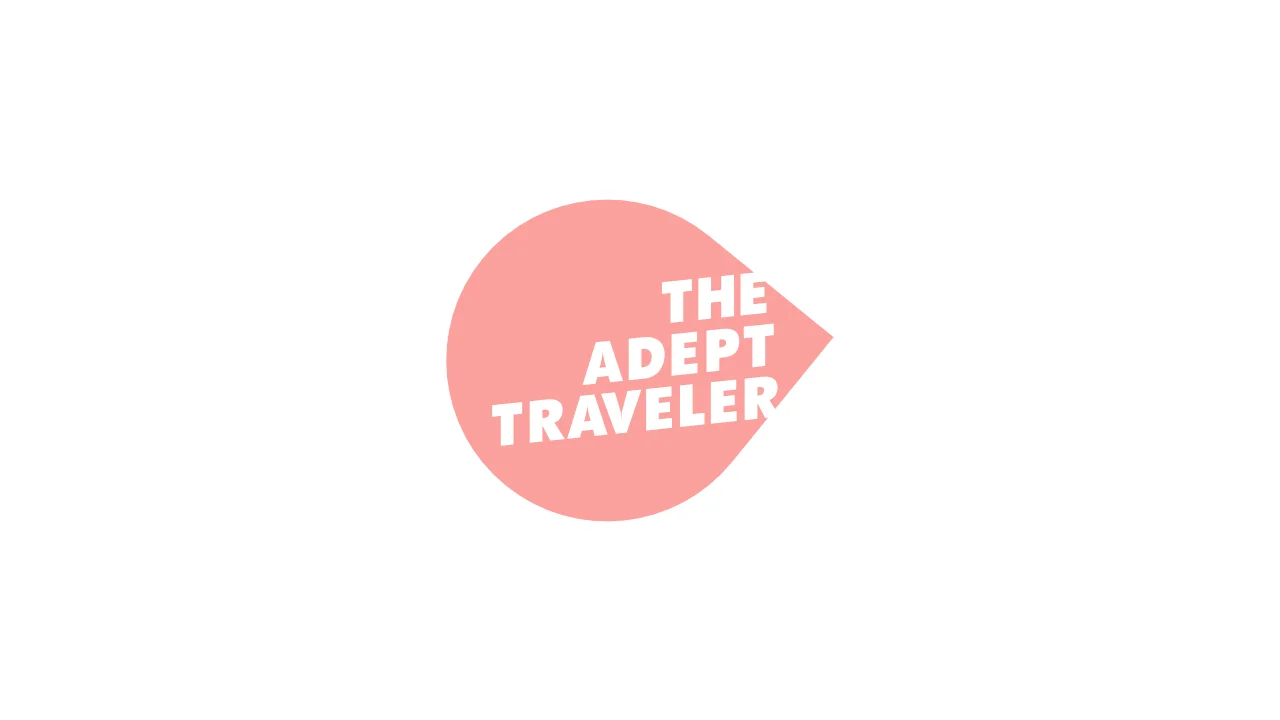
Alta, Norway

Arendal, Norway

Bergen, Norway

Bessaker, Norway

Flaam, Norway

Hammerfest, Norway

Haugesund, Norway

Hellesylt, Norway

Kirkenes, Norway

Lofoten Islands, Norway

Longyearbyen, Norway

Nordfjord, Norway

Nordfjordeid, Norway

Norwegian Fjords

Oslo, Norway

Sandnes, Norway

Sæbø, Norway

Sognefjord, Norway

Stavanger, Norway

Svalbard, Norway

Træna, Norway

Trollstigen, Norway

Tromsø, Norway

Heathrow SAS Cabin Crew Strike Hits Flights Dec 22 to 26

Heathrow SAS Cabin Crew Strike, What to Do Dec 22 to 26

Schengen Internal Border Checks Widespread In Late 2025

Europe Air Traffic Control Delays Worsen, Add Buffers

Europe 2025 Travel Rules Tighten Borders And Costs

2028 World Cruise From Miami To Athens With Azamara
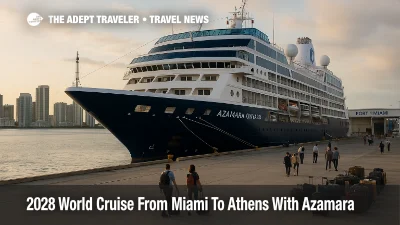
New Melbourne Doha Flights Expand Europe Options

December Strikes Hit Europe, New Zealand Flights, Trains

Europe Rail Pass Sale Offers 25 Percent Off Global Passes

European Airport Delays At Major Hubs November 23-24
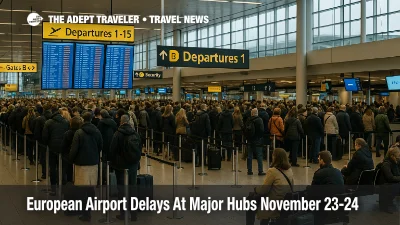
Windstar Opens 2027 Europe Season With 12 New Small-Ship Routes
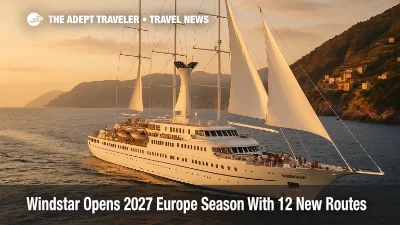
ALG Vacations Black Friday Early Access Through Nov 25

Global Guardian Flags Geopolitics as Top Travel Risk

EU Entry/Exit System: Week one winners and losers

Contiki will cover first-time U.S. passport costs

Havila plans liquefied biogas cruise along Norway's coast
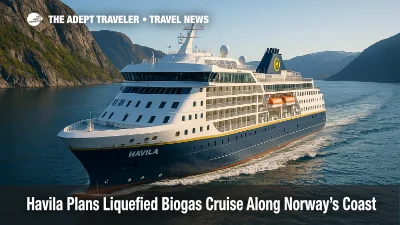
EU entry/exit system starts October 12: what to expect

U.S. warns Europe against capping transatlantic flights
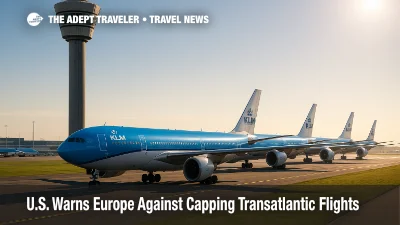
Contiki drops prices on 2026 Europe tours, adds three trips

European Air Travel Update, Cyberattack and CPH Drones

HX Expeditions fall promotion: up to \$2,500 off
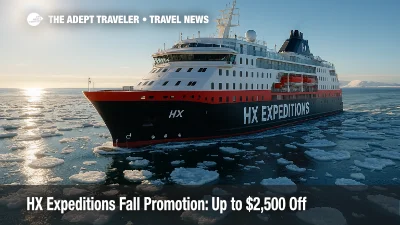
Hurtigruten Norway sale runs through November 16
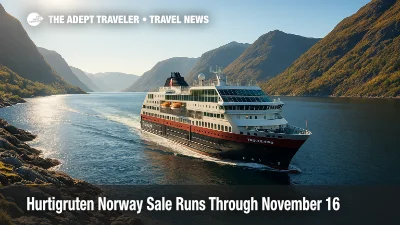
Intrepid Travel Europe tours expand into quieter corners
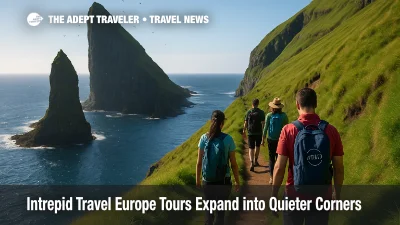
Hurtigruten Svalbard Line adds 2026 land tours
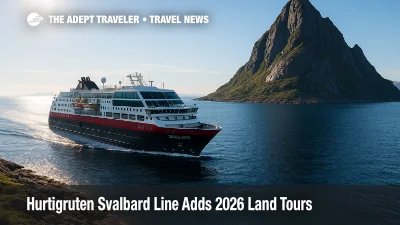
Hurtigruten Svalbard itineraries expand for 2026
